What Are the Best Fruits for Babies?
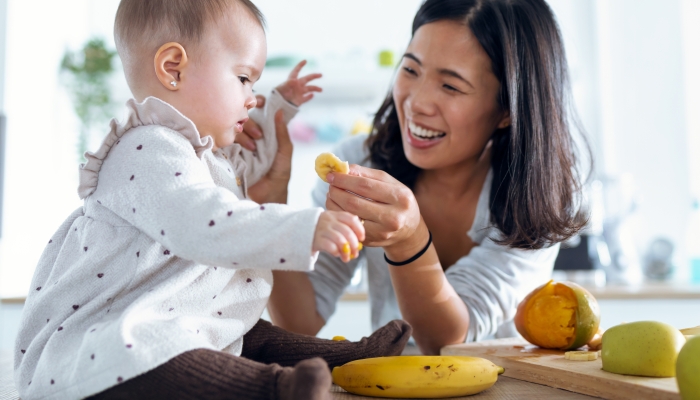
This post may contain affiliate links; please see our terms of use for details.
- Fruits are healthy foods naturally high in vitamins and minerals that promote good health and development.
- Fresh whole fruits are high in dietary fiber, which can promote good digestive health.
- Fruit is sweet and tasty, making it an appealing early food choice for babies.
- Some fruits pose a choking risk to young children, so it’s important to check how to offer each food safely.
Weaning your baby onto solid foods is one of the most exciting stages of that first year of parenthood. After months of side-eyeing your food, it’s finally time for your little one to graduate from their milk-only diet and try some solid food. Whether your baby has consumed breast milk, formula milk, or a combination of the two, weaning is a huge step.
You’ll love introducing your baby to your favorite foods and seeing their face light up when they find something they like. The first few weeks of weaning will be a whirlwind of new tastes and textures. Your gorgeous baby will likely pull some hilarious faces when trying new foods, so be sure to have your phone ready to capture these firsts as they chomp down on the best fruits for babies.
It may take your baby a while to get the hang of solids. For the first few weeks, you’ll probably find most of the food ends up on the floor. If you’re doing baby-led weaning, your baby will be working on their oral motor skills as they pick up food and place it in their mouth (or, more likely, smear it in their hair).
When to Introduce Fruit to Your Baby’s Diet

Fruit is a popular first food for babies, though some believe you should delay the introduction of sweeter fruits. Vegetables have a less sweet and more bitter taste, which many believe is less appealing to babies and young children. Soft or cooked vegetables are a great first food for your baby’s introduction to solid foods.
A 2022 study published in The American Journal of Clinical Nutrition11. Rapson, J. P., von Hurst, P. R., Hetherington, M. M., Mazahery, H., & Conlon, C. A.. Starting complementary feeding with vegetables only increases vegetable acceptance at 9 months: a randomized controlled trial. The American Journal of Clinical Nutrition. 2022;116(1), 111–121. https://doi.org/10.1093/ajcn/nqac080 assessed whether delaying the introduction of fruits would impact how readily babies ate vegetables. The researchers concluded that offering only vegetables for the first four weeks of weaning improved the vegetable intake at nine months. For this reason, you may delay the introduction of fruits and instead focus on vegetables when you first introduce your baby to solid foods.
Top Fruits for Babies
Apples
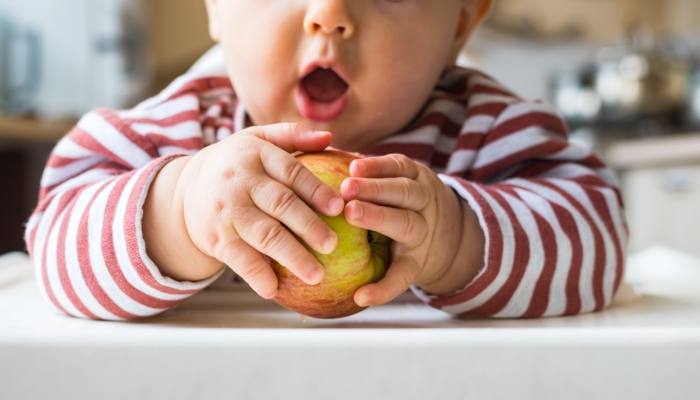
- High in fiber and Vitamin C
- Great for baby food purees
Apples are a classic fruit; tasty, wholesome, and packing a crunch. Apples are high in fiber, so they’re a great fruit to add to your little one’s diet. Most of the fiber is found in the skin, so avoid peeling this fruit before giving it to your child.
You may want to puree or cook apples for younger babies to make them softer and easier to eat. Raw apples can present a choking risk to young children, so it’s important to slice them thinly to ensure they are safe to eat.
Apples are not a common allergen, though people with oral allergy syndrome may react to apples. The reaction is unlikely to be serious and usually comprises of itching or burning sensation in the mouth.
Bananas
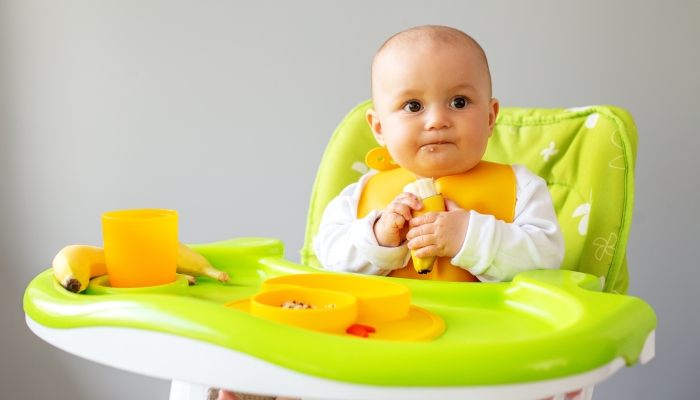
- Excellent source of potassium
- Easily digestible
Bananas are full of carbohydrates to give your baby energy for the day. This tasty fruit contains potassium, folate, vitamin B6, and vitamin C. Bananas are high in fiber, so they’re a healthy addition to your baby’s diet.
Serving bananas as a snack is a time-saving way to give your baby a boost of essential nutrients. To offer bananas for baby led weaning, you should chop the banana in half. This will give your baby a sizeable chunk to hold on to and leave plenty sticking out of their fist for them to eat. If that’s too big, try cutting it in half lengthways to provide thinner spears for your baby to grab.
Avocados
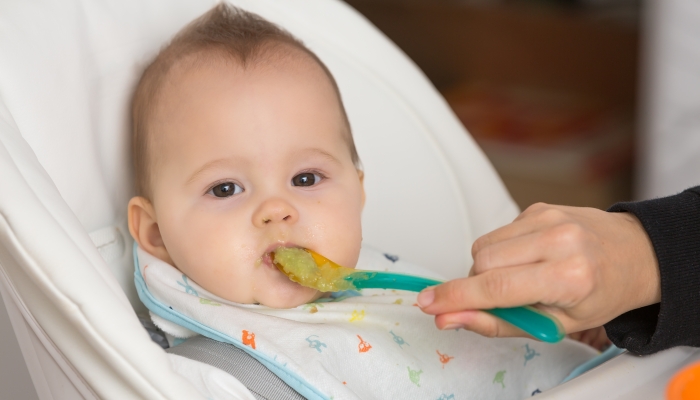
- Rich in healthy fats essential for brain development
- Soft to eat
Avocado is a delicious early food for babies. Rich in fiber, good fats, and essential B vitamins, avocadoes are a great addition to your baby’s plate. Avocados contain plenty of B vitamins and vitamin E, so you know they’re nutritional as well as tasty.
To begin with, you should slice the avocado into spears for your baby and serve them as finger foods. They’ll need a long spear so they can firmly grip one end while tasting the other.
Blueberries
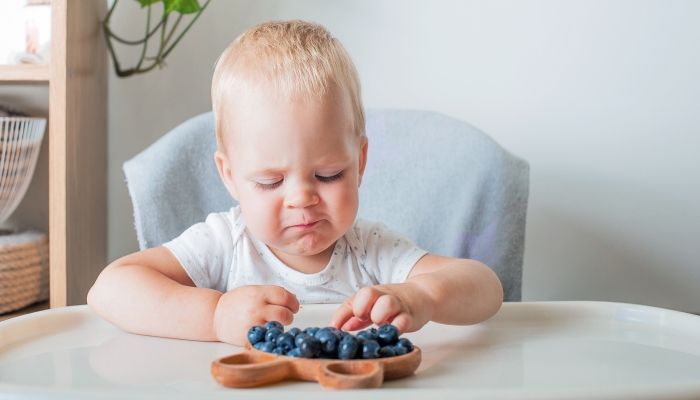
- Packed with antioxidants
- Good source of fiber
Blueberries contain a mix of essential vitamins, including important vitamins C, K, and E. Vitamin E helps iron absorption, so it’s a good idea to serve blueberries alongside foods high in iron, such as lentils and beans.
Blueberries are round, which means they present a choking risk to young children. You can smush the blueberries to reduce the risk or cut them into quarters. Picking small fruits up is great for your baby’s pincer grip development, and trying to grab them is great for the development of motor skills, so it’s good to include smaller foods in their diet.
Peaches
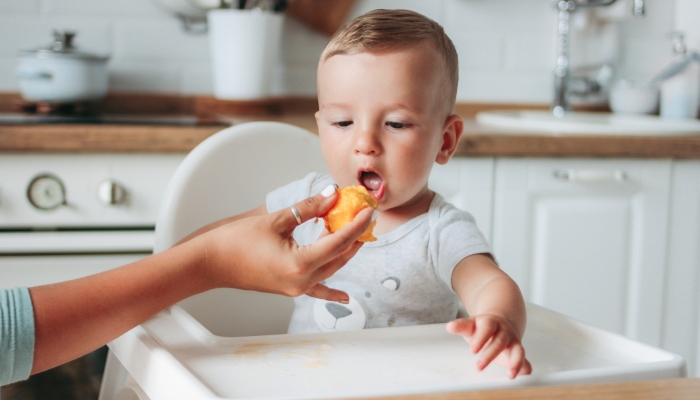
- Contain vitamins A and C
- Peach skin is high in antioxidants
Peaches boast a naturally sweet taste and are juicy, making them a delicious early food for your little one. Peaches contain a good amount of fiber, so they’re great for keeping your child regular. If you’re worried about pesticides, choose organic or make sure you wash the skin well before eating.
Peaches are firm, especially when under-ripe, and they can be quite slippery, which unfortunately presents a choking risk. Always choose ripe peaches, which are softer and less likely to cause your baby to choke or gag. Cut the peach in half and remove the stone; your baby will have plenty to hold on to while they try this tasty fruit.
Individuals with oral allergy syndrome may react to peaches similarly as with apples, so you should introduce small amounts first and look for signs of a reaction.
Less Common Fruits and Their Benefits
Kiwis
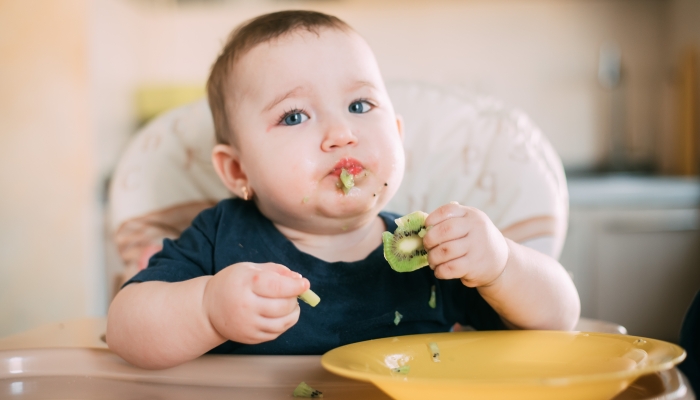
- High in Vitamins C and E
- Contain phytonutrients
Kiwis are high in fiber and offer a good amount of vitamins and minerals to aid development and support health. Kiwis are great for digestive health and can help to keep your baby regular. Kiwis contain phytonutrients that can protect the body and help keep you healthy.
Kiwis present a choking risk because they are firm and slippery. Ripe and overripe kiwis are softer, so these are better for younger babies. When you first introduce kiwis, it’s best to present the fruit whole (peeled), as this will ensure your baby has enough fruit to grip. If your baby struggles to grip the slippery fruit, you could leave the skin on the bottom half so they have something to hold.
Papayas
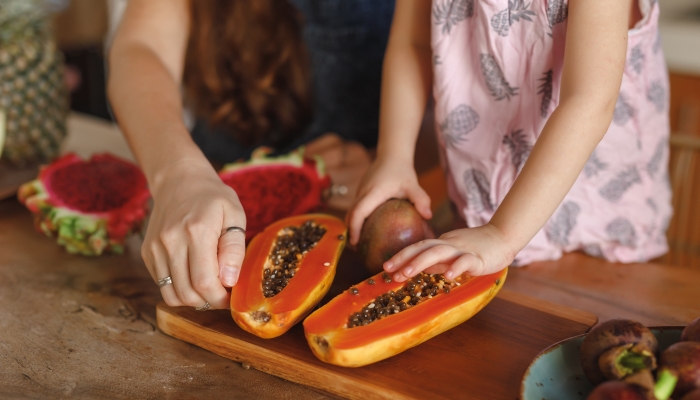
- Excellent source of Vitamin A and C
- Enzymes aiding a healthy digestive system
Papayas contain vitamins A and C, which are great for your baby’s immune system, skin, and eyesight. Papaya has a high vitamin C content, containing more of this essential vitamin than apples, bananas, and oranges.
For young babies, you should cut papaya into long spears. If the fruit is still too slippery, you could sprinkle it with hemp seeds or shredded coconut for extra grip.
The Importance of Fruits in a Baby’s Diet
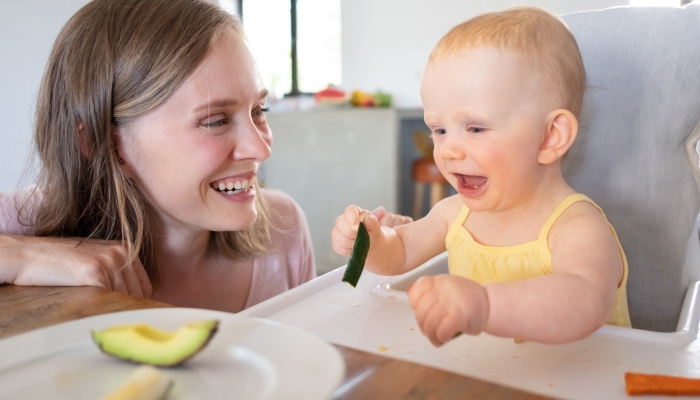
Fruit has an important role to play in your baby’s diet. Fresh fruit promotes health and optimum development. Fruits are high in vitamins and minerals and contain plenty of fiber to help your baby’s digestive system. Fresh fruits and vegetables are an essential part of a healthy, balanced diet.
Weaning is the best time to teach your child good eating habits. Share mealtimes with your baby so they can see you enjoying fresh fruits and veggies, too. Consider yourself a role model to your child and show them how to enjoy a healthy diet.
You should aim to eat plenty of fresh foods each day. It’s important to eat a mix of fresh foods, too. Experts recommend eating a rainbow each day22. Blumfield, M., Mayr, H., De Vlieger, N., Abbott, K., Starck, C., Fayet-Moore, F., & Marshall, S.. Should We “Eat a Rainbow”? An Umbrella Review of the Health Effects of Colorful Bioactive Pigments in Fruits and Vegetables. Molecules. 2022;27(13), 4061. https://doi.org/10.3390/molecules27134061. The goal is to incorporate fresh foods in different colors, as this approach has been found to offer health benefits above simply eating a good number of fresh fruits and veggies each day.
How to Introduce Fruits to Babies
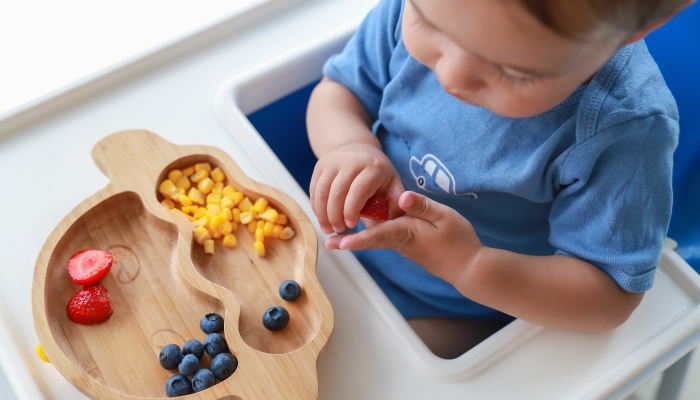
Potential allergens
Most babies will be able to enjoy a mix of fruits without encountering any problems. Some fruits, however, may pose a potential risk. For example, if your baby reacts to certain pollens, some fruits can cause a small allergic reaction. It’s worth offering new fruits one at a time, so you can monitor any potential reactions.
Choking hazards
Some fruits are potential choking hazards for younger children. For example, grapes are a known choking risk and need to be quartered lengthways before they are safe for young children to consume. Be sure to check the safe way of offering fruit in advance, so you can prepare the fruit safely for your child. You can also use a fresh food feeder, which allows your baby to munch on fresh fruit safely while giving them a nice ring to hold on to.
- Feeder helps reduce the risk of choking— only small pieces of digestible food get through
- Perfect for frozen breastmilk, purees, bananas, ice chips and more
- Safely introduce solid foods to boys and girls 6 months and up
- Simply place a piece of fruit, vegetable or even meat into the mesh bag and snap it shut
Babies with special needs may have trouble swallowing thin liquids, so juicy fruits like watermelon, oranges, or peaches may cause coughing. If you notice a lot of coughing with juicy fruits, you should take your baby in for a swallow study to see if they need to be on thickened liquids.
As always, stay close to your child while they eat. For your own piece of mind, it’s worth doing a baby first aid course to learn the difference between gagging and choking and how to react in an emergency.
High acidity fruits
Babies have immature digestive systems, so it’s important to be gentle with them as they are weaning. Some fruits contain higher levels of acid, and this can be tough on tiny tummies. For this reason, you may want to limit the amount of citrus fruits offered to your baby in the early days.
References
- Rapson, J. P., von Hurst, P. R., Hetherington, M. M., Mazahery, H., & Conlon, C. A. (2022). Starting complementary feeding with vegetables only increases vegetable acceptance at 9 months: a randomized controlled trial. The American Journal of Clinical Nutrition, 116(1), 111–121. https://doi.org/10.1093/ajcn/nqac080
- Blumfield, M., Mayr, H., De Vlieger, N., Abbott, K., Starck, C., Fayet-Moore, F., & Marshall, S. (2022). Should We “Eat a Rainbow”? An Umbrella Review of the Health Effects of Colorful Bioactive Pigments in Fruits and Vegetables. Molecules, 27(13), 4061. https://doi.org/10.3390/molecules27134061
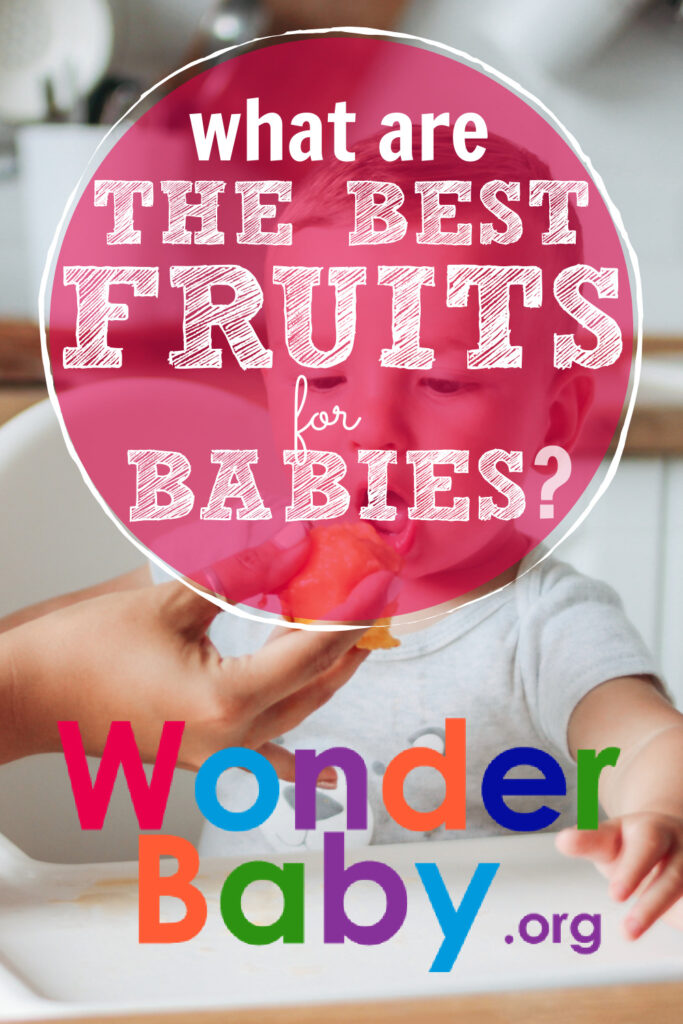
Related Posts
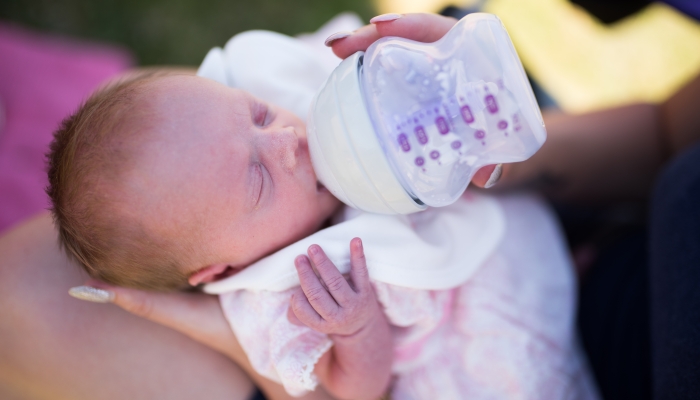
Feeding and Eating, Special Needs
Feeding Therapy Approaches for Infants with Special Needs
Many children with special needs have feeding difficulties. Working with a speech therapist, being patient, and experimenting with textures can help.

Feeding and Eating
Unexpected Foods That Cause Allergen Cross-Reactivity
A variety of unexpected foods and environmental substances can trigger an allergic reaction through cross-reactivity to food proteins.

Feeding and Eating
Easing Anxiety for Families Facing Food Allergies
Ongoing physical preparations and speaking openly about anxiety can ease the transition from diagnosis to living well with a food allergy.
